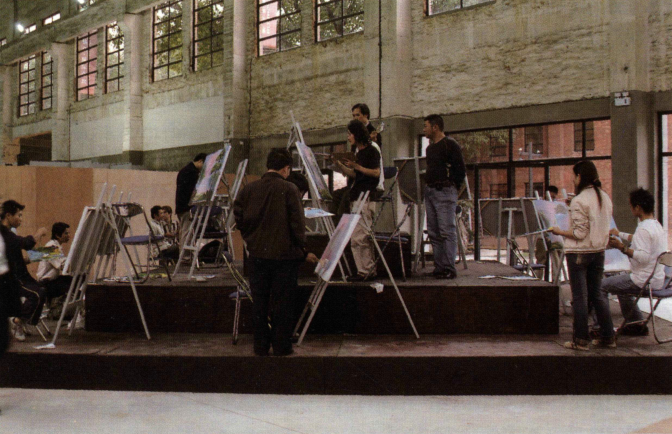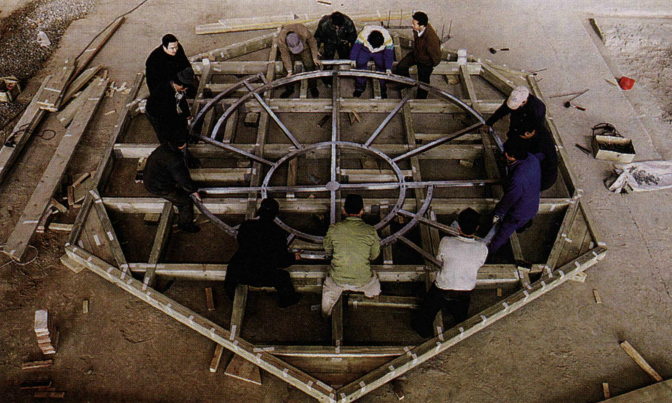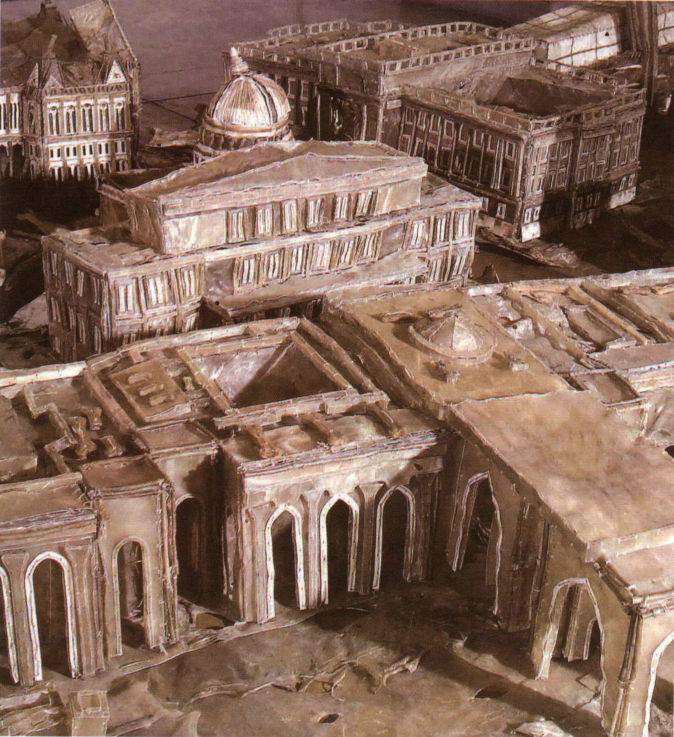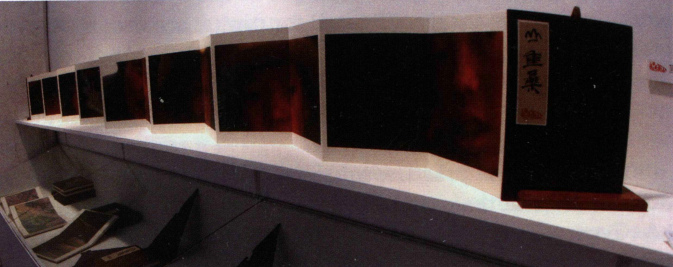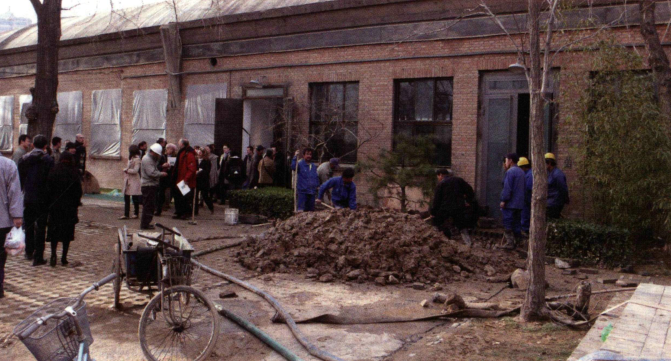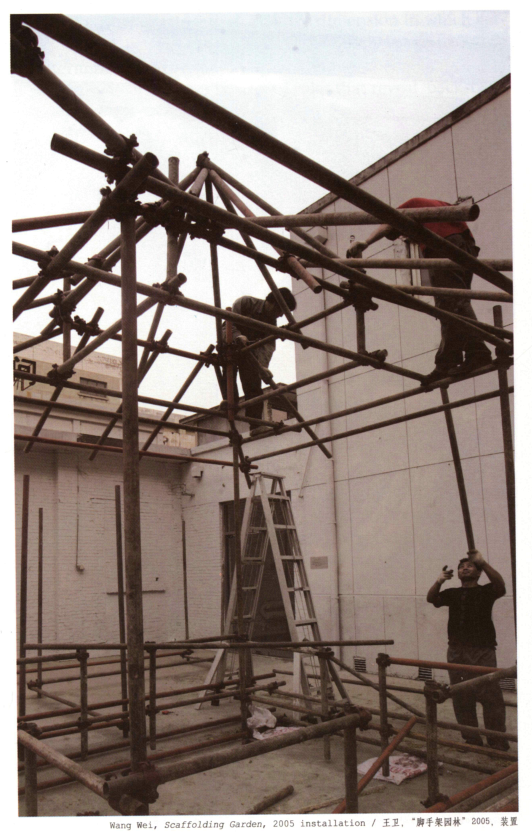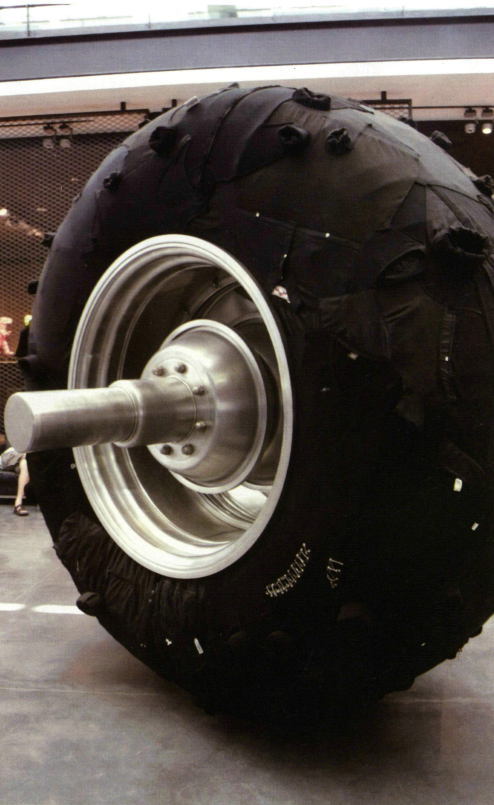Introduction
On November 17, 2005, thirteen young men and women arrived in Guangzhou from Dafen oil painting village located about 90 kilometers away near the city of Shenzhen. They had been hired by the young artist Liu Ding to “perform” their day jobs, making oil paintings throughout the opening of the 2nd Guangzhou Triennial. On a three-tiered triangular platform, the painters were arranged according to skill level and task; the majority of them were stationed on the bottom tier, and the smallest of the three groups was stationed on top.
For four hours the painters painted, creating forty near-identical landscapes. The goal of this performance, entitled Products, was to sample the economic ecosystem of Dafen; in the artist's words, the project “imitates and demonstrates the assembly line of making, producing, and displaying “artworks” in a concentrated way within a museum setting. ”1Liu Ding: Products, p.10. The project has received widespread attention for its cogent approach to the hot-button issues of manufacturing, labor, and art production, and for its piercing critique of museum culture and context, with the forty paintings produced there living on––now in the form of assisted readymades––in Liu’s subsequent installation projects. But with Products, Liu also unintentionally created a small-scale model of the art production system which exists not in museums but in artist studios themselves.
Ai Weiwei’s exportation of 1001 Chinese citizens to Documenta XII in 2007; Zhang Huan’s twenty woodcarvers whittling his Memory Door series, 2006; Liu Wei’s team of workers hand cutting and sewing rawhide in the shape of world monuments for Love It, Bite It, 2006; Yan Lei’s work crew filling in oil paintings according to his paint-by-numbers system; Lin Tianmiao’s flock of local women spinning and tying thread in her home studio; Yin Xiuzhen’s group of helpers sewing used clothing together for her sculptures: this is only a brief sampling of recent projects and practices that demonstrate the affinity of contemporary Chinese artists’ for hiring workers, assistants, and artisans to aid in the production of art. While only some of these practices are presented as conceptual ends in themselves, they all represent ways in which human labor (and more specifically, human wage labor) is currently being invested in the production of art objects in China. Multiple factors lie behind this turn toward outsourcing and mass production, including the demand generated by the (over)heated international art market, the global surge of biennials, art fairs, and large-scale periodic exhibitions, and––perhaps unique to China––the ballooning size and number of art spaces. Artists in China are producing more and bigger artwork than ever before, and they are producing it faster than ever before, all in the interest of feeding the public’s seemingly limitless demand for paintings, art objects, installations, and sculptures. Expediting production with the use of hired help has become the rule rather than the exception, and as a result, more and more of the art we encounter––whether on the auction block or in a museum––was produced not by the artist’s hand but by those of anonymous individuals.
There are of course countless historical examples of Chinese artists hiring others to paint for them, from Qiu Ying to Zhang Daqian and Chen Yifei, and just as many current examples of outsourced international fabrication, from the work of Jeff Koons to that of Damien Hirst. However, here I am most interested in the overlap of untrained and specialized work in the production of contemporary artwork, and in this regard, China provides an exemplary case.
In the 1980s, “avant-garde” Chinese artists, whether working alone or in groups, created art on an individual scale determined by the narrow means available to them. Experimental ideas were often carried out in what were then deemed to be experimental ways, with little need or regard for hired assistance. Hands-on exploration was not only a key component of the artistic process, it was unavoidable, since minimal public exposure and a lack of official acceptance severely limited experimental artists’ access to financial support. Of course, China’s precipitous step toward a market economy in the 1990s brought Chinese artists heightened attention from international curators and collectors, but domestic art circles remained small; artists here continued to approach art-making as primarily a solitary, insider-oriented activity, and had little recourse to or desire for the grandiose methods of art production we know today.
Enter today’s global market, where commercialism, privatization and the accelerating pace of transnational capital movement have penetrated all spheres of urban life, and where record-setting auction prices and art investment hype fuel the production of contemporary art on a monumental scale. During the three-month period from March to June 2008, Beijing witnessed the opening of dozens of new art spaces, including Iberia Center for Contemporary Art (4000sqm), Joyart (400 sqm), T-Space (1200 sqm), the Beijing branch of Shanghart Gallery (700 sqm) and SZ Art Center of Hunan Fine Arts Publishing House (800 sqm). At the time of writing, American blue-chip dealer Pace/MacGill is in the midst of preparations for the opening of what is believed to be a 2000 square meter space; the opening is scheduled to occur on August 8, 2008, the very day of the opening ceremonies for the Beijing Olympics. Rumors abound about more expansive art districts still in the blueprint stage––from Shanghai to Xi’an to Beijing.
Given the onus upon artists to fill these and other spaces, “production” is the only operative term for many current artistic practices in China. Further proof of this, should any be needed: it is not considered unusual for an emerging twenty-something artist to fill spaces upwards of 1000 square meters for their first solo exhibition.2It should be noted that gallerists have been known to offer their artists access to cheap labor to help them expedite production and meet exhibition deadlines. The push towards increasing output and productivity is therefore not strictly a decision that rests upon artists themselves but can come in the form of external pressure. Earlier this year I spoke to an artist who had five openings in the span of one month, all taking place outside of China, and in late 2007, another artist opened four solo shows in Beijing at different galleries at the same time.3The four exhibitions by Shen Shaomin were “Bonsai”, Courtyard Annex, Beijing; “Tiananmen”, Today Art Museum, Beijing; “Fighter-X”, Platform China, Beijing and “Kowtow Pump” at Tang Contemporary, Beijing, China. Given the frequency and size of these exhibitions, and given that the majority of them require new works to be made, it is clear that many Beijing artists are hard up against the limit of what any one artist could produce individually. Yet most would agree that the reliance upon assistants and workers has gotten out of hand, with fewer and fewer artists giving time and effort to fully engage with the layered processes of artistic production.
In China as elsewhere, the definition of “artist” is under constant revision. Artists are no longer seen as sole creators of art objects, but as producers: as initiators and directors of a process that is increasingly socially, culturally, and politically invested. Delegating to workers, instructing assistants, and negotiating with companies and institutions are seen not as activities in conflict with individual artistic creation, but rather as natural side effects of a contemporary art practice that is growing increasingly diffuse, overlapping as it does with the fields of architecture, science, design, and fashion, and spanning across geographical borders and time zones. In regard to the production side of artmaking, which has long been linked to questions of media, the traditional categories of sculpture, painting, installation, and photography now slide into one another as artists, in Hal Foster’s terms, make decisions “horizontally” across different media rather than “vertically” within them. And whereas artists were once seen strictly as makers, their parallel roles as producers, facilitators, commentators, and cultural critics have propelled them into positions that extend beyond the autonomous world of art into the social praxis of life.4See Hal Foster, “The Artist as Ethnographer” in Return of the Real, pp. 171-203.
Long-held assumptions that define art in terms of “craft” have also largely fallen by the wayside. As artist Ai Weiwei notes, “Now an artist comes up with an idea, directs production and makes judgments. ” Though this statement is of course applicable to most conceptual art practices around the world, it is worth considering the specifics of how this process plays out in different locales: given that spheres of work and production are culturally defined, the nature of the work and of those that are hired to do it are not the same in New York or Berlin, Mumbai or Dubai. It is also worth questioning the nature of such an approach that appears to value a priori ideas and concepts over the processes of making and shared experience.
In China, where labor is cheap and plentiful, and where pronounced class differences, socioeconomic disparity and rapid changes to the urban environment are facets of everyday life, the managerial role that many artists inhabit manifests itself differently than it might elsewhere. China’s explosive economic growth and rapid development are fueled by an enormous number of wage laborers (known broadly as migrant workers, or just workers) some 200 million strong nationwide; in Beijing alone, they number approximately five million, nearly a third of the city’s total population. These contract workers with no fixed urban residence constitute a vast pool of affordable and accessible labor, and as a result, artists of all positions and ranks, all ages and experience levels, now consider it their prerogative to reap the economic advantages of the “Chinese miracle” in the form of paid workers, assistants, and artisan-workers. In fact, taking advantage of these conditions is now deemed not just practical but fiscally prudent. Why do it yourself, the argument goes, when you can pay someone-at fractional cost-to do it for you? The current excess of labor also means that the spectrum of tasks funneled through assistants and workers grows ever broader, from ordering materials, responding to emails, and handling computer files to stretching and preparing canvases, and from making tea to packing and crating artwork. In some cases the laborers are also sewing the fabrics and carving the wood and painting the paintings, in a sense repositioning them as extensions of the artist’s hands. According to Ai, this widely accepted new way of working “frees the artist from having to master skills, and introduces new materials and techniques. ”5See “The Art of Production”. This entire issue of Artforum is dedicated to questions of production, with short excerpts written by artists called “Production Notes”. This quote and others are drawn from Ai Weiwei's Production Notes, Artforum (October, 2007), p. 324. And yet one wonders, What then is the relationship between conceptual art and skill, and has anything more problematic than new materials and techniques been introduced to the process?
Labor in the art world comes in many forms: “workers” (usually uneducated men from the countryside who perform manual tasks for a low daily wage, and who have no previous training in art); “assistants” (usually students and graduates from studio art departments or fine arts academies who perform office-related tasks and/or contribute their own artistic skills to the making of an artwork); and “craftspeople” or “artisan-workers” (men and women from provinces such as Zhejiang, Anhui and Guangdong who have specialized skills such as woodcarving or joinery). An artist’s studio in China might contain any or all of these forms of labor, depending on what is being produced. Both “workers” and “artisan workers” can be defined as wage laborers, a designation that speaks not only to their socioeconomic position but also to their educational level, which is invariably dramatically lower than that of the artists who hire them. The sheer quantity and availability of these workers and assistants heighten their involvement in all aspects of production: they are ubiquitous, and their pervasive presence transforms what is possible in the making of art in terms of budget, size, and time, and yet these workers are mostly invisible in Chinese art circles. They are a sort of backstage crew to the set of performers known on the international stage as “contemporary Chinese artists. ”
Rushed timelines, censorship concerns, and slapdash construction aside, the benefits of being an artist in China right now are abundantly clear, and not just to those who live here full time. Thanks to the oversized pool of cheap local labor, artists from around the world find opportunities not afforded to them in their home environment, adding a global layer to the already complex web of artists, assistants, workers, and studio managers that populate the Chinese art scene. For Chinese artists, optimal economic conditions have dictated entirely new ways of working, leading them not only to hire more workers and to delegate more and more of the process, but to enact factory-like modes of production that advocate a post-authorship position. However, the most easily attainable means of “freeing the artist’s hand” turns out to be not a machine, a technology or an industrial process, but another person’s hand.
The shift towards “human mechanization” pervades the landscape of art production in China, setting up some disturbing parallels to the turn of the century conditions that gave rise to Marx’s theory of alienated labor. What motivates the lines of production within the art world is not always a desire for efficiency or a reflection of relaxed attitudes towards authorship; often it is simply a push towards greater productivity and commodification. By invoking others in the process, the artist does not remove questions of craft and skills, but rather places them front and center.
My specific task here is to offer a means by which to understand art in China through the social politics of production, rather than through the common interpretive rubric of iconography and representation. As artists in China rely ever more heavily upon the “outside help” of workers and artisans, an evaluation of the tripartite relationship between these practices, the art produced, and the larger social context becomes ever more important as a means of generating new lines of access to the art itself. The ongoing treatment of authorship is intended not to settle questions of attribution and credit, but to address those questions critically with respect to the cult of individualism that surrounds the capitalist system. Whose labor is encoded in the art object? Whose labor is valued, who does the valuing, and why? To what extent can we see the presence of this labor politically, as constitutive of a social presence, and therefore requiring some level of participation on the part of artists? And what new perspectives on collaborative processes and/or social practices might the increasingly fraught relationship between art and labor in China yield?
Process over product
Attention to process rather than product, to means rather than ends, remains curiously absent from most contemporary art criticism both inside and outside of China. It would seem that capitalism's predilection for products has enabled concerns about meaning, expression and representation to take precedence over the particulars of how a given work was made or produced. In recent years, writing on contemporary art in China has been propelled by a breed of social criticism that relies upon the analysis of finished artworks as reflective or illustrative of certain societal or political conditions, with only glancing acknowledgement of the systems of making that make such works possible in the first place. Turning our gaze away from the finished work and towards the process of production, as I intend to do, is in part a way to detour away from predictable interpretations of iconography and representation in favor of a more nuanced look at the art-and-politics question. Inclusive as it is of the material processes that underlie art production, my interest here is not in applying a Marxist reading centered on issues of value or labor theory, but in considering more broadly the range of social interactions that surround and infiltrate aspects of production. What is contemporary art's relationship to China’s current political economy?
Enfolding issues of participation, collaboration, and collectivity into my discussion is part of this endeavor. While I do not intend to argue that the artists I mention are, strictly speaking, engaged in the task of producing relational or participatory art, or that the practices of working through assistants and workers should be universally recognized or presented as collaborative or collective, I will argue for the applicability of the theories on which such practices are founded to the conditions of contemporary art in China.
Of particular interest is the resistance provided by these theories to market-oriented approaches placing consumption and a cult of individualism at center stage, and the ability of these theories to speak to the time-space in which inter-human relationships are formed. Bourriaud defines the latter as “relational space,” and asserts that the gradual mechanization of social functions is leading to its slow disappearance.6See Bourriaud, Nicolas. Relational Aesthetics, p.17. Given that current art production in China often finds itself in the opposite situation, with humans taking the place of machines and thus increasing the amount of “relational space” and social contact, it seems only appropriate to bring the sphere of inter-human relations that defines relational aesthetics into dialogue with the social relations present in art production. Moreover, participatory art theory proposes going one step further by looking at the collective dimension of social experience and a “restoration of the social bond through a collaborative elaboration of meaning.”7Bishop, Claire. “Introduction: Viewers as Producers” Participation. p.12 Here participation and collaboration are not rigid formulations, but are defined as attitudes or outlooks that cede some or all authorial control to others, and/or grants the artistic process greater openness and unpredictability through the input of and exchange with others. Artistic production is thereby seen to focus on the relationships and interactions of the various producers of a given piece, rather than on the ways in which a particular art object may or may not function or be received outside of the studio.
To dismiss the practice of using hired assistants or workers in art production as simple “outsourcing” would be to ignore the full constellation of efforts and hidden processes that bring an artwork into existence and contribute to its final meaning. Permutations of these processes effect not only reception; in fact they can constitute an important part of the work itself. If the notion of producing constitutes a bringing forth, or in Ranciére’s words, “the act of defining a new relationship between making and seeing,” then the act of aesthetic production unites terms that are traditionally opposed: the activity of manufacturing and visibility.8See Ranciere, Jacques. The Politics of Aesthetics, pp. 44-45. In Brechtian terms, the production is thus no longer solely about what is presented on the stage, but about the entire apparatus, including the slippage between audience and participant. And yet, the questions of doing, making, being, seeing, and saying that encircle issues of production are enmeshed with those of labor, and where labor is involved, politics are not far behind. If we take political questions to emerge from the systems of control that exist to modify human interactions and behaviors extant both within and, especially, beyond the framework of “art,” then the process of production, and in this case the presence of a non-art specific labor force, is unavoidably political in nature. Thus a dismissal of the political aspect of production through disregarding the laborers’ presence suggests a desire to return art to a state of autonomy, cut off from the social concerns of the world.
Economies of scale
In 1989 Gu Dexin remarked, “Except money and big studios, Chinese artists have everything they need.” Today, one could certainly argue, artists have much more than what they “need.” Huge studios are outmatched only by massive galleries, many of which have pockets deep enough to realize ever more grandiose installation projects. And outside the physical space of the studio, demand for site-specific or site-oriented projects is running at an all-time high, fueled by the ever greater number of global biennials, triennials, art fairs, and large-scale exhibitions in increasingly remote corners of the world. The growing privatization of industry and a recent real estate boom have led to an unprecedented merger of art and commerce, with museums, commercial galleries, and specially built art districts multiplying apace. The booming expansion in the art world and growth in luxury housing and commercial construction projects are all keyed towards a massive scale and are made possible by an invisible and inexhaustible source of human labor. The over-idealized notion of “the masses” and visions of collective labor have seduced intellectuals inside and outside China for decades, giving rise to the belief that “anything is possible”––i.e. nothing is too big or too complicated to be built and no time frame too short to accommodate. Mao once said “I have witnessed the tremendous energy of the masses. On this foundation it is possible to accomplish any task whatsoever”. This logic has been internalized by many artists today, who strive for “efficiency” through shortcuts like hiring assistants and initiating grand scale projects that undoubtedly rely upon the “hidden masses” to bring to fruition.9My usage of the term “hidden mass” is to be distinguished from its scientific applications (translator's note). Currently, building projects grow more and more gargantuan, shows overflow their spaces, exhibition catalogs grow ever thicker; production schedules are squeezed into impossible timeframes, and when it comes to the making of art itself, what is emerging today is a transnational political economy of production that links art not only to a new scale of the economic, but a new economy of scale, in which mass production and the space of work are extensively reconfigured for capital accumulation on a global scale.
Production in the social context
The panoply of practices involving labor, work, and mass production listed at the outset of this essay are a small indication of how events in the art world echo those of the larger social sphere. In the same way that artistic production among postwar American pop artists and minimalist sculptors was transformed by the rise of mass production, the language of industrial materials, and the topos of the machine, so Chinese artists of today are responding to the current production-centered economy that is immersed in manual labor and the growth industries of construction, development and manufacturing. Much as Zhang Huan’s 1994 performance 12 square meters inside a foul public toilet stands in for the downtrodden pathos of the 1990s, and Lin Yilin’s Maneuvering Across Lin He Road (1995) represents the sweeping forces of urbanization, both the factory lines of Cao Fei’s Whose Utopia (2006-2007) or Zheng Guogu’s Processing Factory (2008) come to signify an era obsessed with production, manufacturing, and construction whose counterpoint is the unseen labor that brings it all to life.
Another form of response, and the subject of this current study, is the evocation (conscious or otherwise) of the ethos of production with regard to artmaking itself. The growing ease of outsourcing, the transnational flow of goods and services, and the expansion of multinational corporate entities in China have together set the stage for artists to employ (literally and figuratively) human labor in their own creative process. But where, if any, are the boundaries to such practices? What can they tell us about contemporary art in China? And how does the collective presence of wage laborers in art production change the relationship of art to society?
In 1986 a group of artists known as Xiamen Dada working in southern China decided to move ordinary objects––construction materials, garbage, furniture––found in the neighboring courtyard into the exhibition hall of the Fujian Art Museum. The Events Exhibition That Took Place at the Exhibition Hall of the Fujian Art Museum, 1986, was not an exhibition of paintings or sculptures, nor was it designed to comment on whether the items were objectively to be considered works of art; it instead “indicated a form of exhibition with unlimited boundaries.”10House of Oracles: A Huang Yong Ping Retrospective, notes from Huang Yong Ping's writings, p. 38. The action was one of many “attacks” instigated by the Xiamen Dada group, led by French-Chinese artist Huang Yong Ping.11For more information on Huang Yong Ping and Xiamen Dada activities, see House of Oracles: A Huang Yong Ping Retrospective; Martina Koeppel-Yang, Semiotic Warfare; and '85 New Wave Archives lk Xiamen Dada. Huang Yong Ping, Fei Dawei, ed. Their radical anti-art stance was an important aspect of their call to blur art and life by using actions, events and dematerialized concepts to confront ideological systems that confined art’s position within prescribed societal and institutional frameworks. Yet now that contemporary art in China has finally shed its previously ubiquitous “avant-garde” slogan, perhaps it is time to revisit these socially charged prescriptions in earnest. Contemporary art in China need not go so far as to adopt a relational stance or even take on the participatory call to “repair the social bond,” but rather to acknowledge that such a bond exists in the first place.
The very act of opening a newspaper, of walking past a construction site or visiting a factory entails a confrontation with the vast social disparities and imbalances that accompany spheres of production and manufacturing in China, yet attention to this confrontation is routinely discouraged by a call for art that is a product of these surroundings yet is largely detached from its immediate context of production. Moreover, the artist’s detachment runs both ways: artists hire others to fabricate, paint, or produce their work, and are thus distanced from the materiality of the objects being produced; at the same time, the artist’s obsession with producing commoditized saleable art objects discounts the intangible relationships and interactions that enable the very existence of such objects, thus distancing the artist from the messy affairs of contemporary political life.
Such forms of detachment must of course be seen in the context of their opposite number, namely participation. The call to participation that surrounds much international contemporary art practice today is part of a larger dialogue centered on the social dimension of participatory, collaborative or collectively produced art that arguably situates itself within a history of avant-garde and dematerialized art forms.12Claire Bishop brings attention to this in her introduction to Participation. See pp. 10-17. Though participatory art is not strictly the same as relational or interactive art, it shares their theoretical underpinnings, as well as a philosophy which holds that the sphere of human relations and social situations is a fruitful departure point for artistic production.
A key trajectory behind these practices is rooted in the postmodern crisis in authorship, as articulated by Roland Barthes in his 1968 essay “The Death of the Author,” which though ostensibly addressing the field of literature was taken to heart by many visual artists from the 1970s onward. Barthes’ principle idea was that the voice of the original author was overvalued, and that the authorial process of quotation from and reference to existing sources and voices leads eventually to a point where the text itself speaks, not the author. Thus, in Marxian terms, the author is a historically and socially constituted subject. In Barthes’ theory, the artistic process is incomplete without the presence of a reader (or, for our purposes, a viewer) to synthesize the quotational or referential units into a comprehensible whole; in other words, a point of reception is necessary to make a work of art complete. For many artists, Barthes’ theory signaled not only the death of the author but also the death of the object, ushering in an era of installation art and other dematerialized art forms. Authorship was also tied to historical notions of genius and artistic singularity which aligned with the troubling status of art as a commodity. This paradigmatic shift to a world in which artistic production is governed by the viewer or receiver pointed out the door through which art was soon to leave the safe confines of pure aesthetics in order to interact with the broader social sphere. The many theories on reception and consumption that preceded and followed Barthes are united by the overarching goal of bringing art closer to the viewer, and, in the process, drawing contact with its social environment and other individuals.13See Guy Debord, “Towards a Situationist International,” and Jacques Ranciere, "Problems and Transformations in Critical Art," both published in Participation; Claire Bishop, “The Social Turn,” Artforum (February 2006); Grant H. Kester, Conversation Pieces: Community + Communication in Modern Art; Nicolas Bourriaud, Relational Aesthetics; Guy Debord, The Society of the Spectacle; Jean Baudrillard, Simulacra and Simulation.
Recent international fascinations with socially engaged art, community-based art, and participatory or relational art––all of which stress the process and space of inter-subjectivity over the concrete production of an art object––have found few expressions in the Chinese context. Perhaps China’s surging forces of capitalism, its rhetoric in regard to the “knowledge economy” and its rigid societal structures are all less than conducive to an environment in which the inter-human relations connected to production are seen as credible components of an artistic process which values, among other things, an openness to unscripted or collaborative components. Most works here possess a collective dimension, but authorship is resolutely individual, the artists clinging to the retrograde ideologies of capitalist institutions (museums, art market, the academy, media) which favor unmediated relationships between the work and the “named” author, instead of attempting to overturn or dismantle them. The questions scholars, critics and artists have put to art over the years concerning a work's relationship to other works, to itself, and to society, have shifted toward a consideration less of process than of the individual artist’s relationship to society, of his or her stake in the realm of human relations and everyday reality.
As many scholars have pointed out, Chinese society has always been acutely aware of hierarchical structures and sensitive to social networks, with each person occupying a clearly defined niche. Relationships between people are largely determined by the relative locations of their social niches or functions. Centuries of Confucian-based moral codes and principles of conduct, now filtered through decades of socialist political culture, have led to carefully delineated individual roles within Chinese society; said roles often contain a performative dimension in which certain actions or behaviors are expected or anticipated as though predetermined. Improvisation, chance and unpredictability tend to be undervalued, as are unscripted roles that reveal “backstage” maneuvers once intended to remain hidden from view. Chinese art educational models have long been recognized to stress learning by example, with repetition and the copying of established styles forming the preferred routes to acquiring knowledge, rather than a process of open-ended experimentation and exploration. As a result, a great deal more importance is given to the perfectly representational than to the accidental, and where contemporary art is concerned, the finished product is privileged over the flexible contingencies of making. Moreover, the programmatic functions associated with performance are also felt in the self-presentation of artists today, who eagerly adopt the prescribed role of individuated author or studio manager.
The inherent tension between the modernist discourse that places value upon the mark of the individual and the postmodern critique of such individualized authorship can be seen to crystallize around the space of artistic production. From Foucault to Barthes, the positivist mode and the centrality of the author have been interrogated, disputed, and even deposed. Efforts to suppress the artist’s hand through mechanical reproduction and appropriation, through other people's labor, and through the dematerialization of the object have been part of this task. Yet such efforts are most often critically framed within theories of consumption and viewer reception, and pay far less attention to the actual processes of making.
I have thus divided this essay into three different investigative sections. The first explores the anxieties that circumscribe authenticity and authorship within the realm of painting and image-based practices. The “craft” of painting carries a unique set of ramifications when seen alongside the practice of hiring assistants and workers, and here I have specifically chosen artists who make a habit of hiring untrained and uneducated workers. Looking at artists who use workers and assistants to conceptual ends, I hope to show how these practices, though attempting to subvert authorship through automated and mass production methods, reveal themselves to be nonetheless reliant upon individuality and singularity. In the case of artists such as Yan Lei, Zhou Tiehai, and Liu Wei, the mark of the human touch is problematized; seen in the context of a market economy that favors “named authorship” and individuality, their reliance upon uniqueness falls short of a truly critical stance.
Materials and media are also inextricably tied to questions of production, and thus form the second area of investigation. Lack of media specificity and emphasis on conceptual practices over craft-based skills leaves open the choice and “handling” of materials. As production methods grow more complex and come to require skilled technicians or craftspeople, new authorship concerns arise, and complicate the role of the artist: these artisans increasingly lend their hands to the finished result, calling into question the roles often ascribed to artists and assistants, and problematizing any lack of public recognition in regard to their contributions. Artists like Zhang Huan and Ai Weiwei perform a reversal on the “outsourcing” model by “insourcing” or “hiring in” wage laborers to make their work; a close consideration of such art leads to a re-examination of the usual dichotomies of inside/outside, private/public, and individual/collective often associated with studio practice.
The third section of this essay looks at work made beyond the studio itself, incorporating practices loosely defined as “site-specific.” As the process of making becomes dispersed and decentralized in any move away from the physical site of the studio toward the larger social sphere, issues of authorship and production are again foregrounded. Likewise, the economies of scale dominating artistic practice in China demand that more and more artists rely upon others to produce their work, but these practices take a continually detached position vis-a-vis both production and presentation. “Site-oriented” projects by Xu Zhen, Liu Wei, and Liu Ding demonstrate different approaches to such production, and to the means by which these approaches can either incorporate or deny the social considerations of any given site.
Though I have framed my discussion of production around concerns of authorship, my underlying concern is centered not on knowing whether an artist produced work with his or her own hands, but on how the work was made, and on what else was produced in the process. As contemporary artists adopt more complex relationships to the modes of production signified by their hiring of workers and assistants to produce their work, a series of roles are enacted that, once brought into consideration, affect our vision of art's potential role within society. As artists consciously or unconsciously invoke the ideology of mass production and distributed labor, we must ask, To what end? Is the role of the artist to be defined by one’s capacity to delegate tasks and name the results as one's own? And leaving aside the demands of the market, might there be a purpose to production that encompasses broader realms of participation and social interaction among different peoples and individuals? Or in the words of Hans Ulrich Obrist, if collaboration is the answer, then what is the question?
This article was originally published in In production mode: contemporary art in China by Pauline J. Yao.
Pauline J. Yao is Lead Curator, Visual Art, at M+ in Hong Kong. Her recent exhibitions at M+ include “In Search of Southeast Asia Through the M+ Collections” (with Shirley Surya) and “Five Artists: Sites Encountered.”
